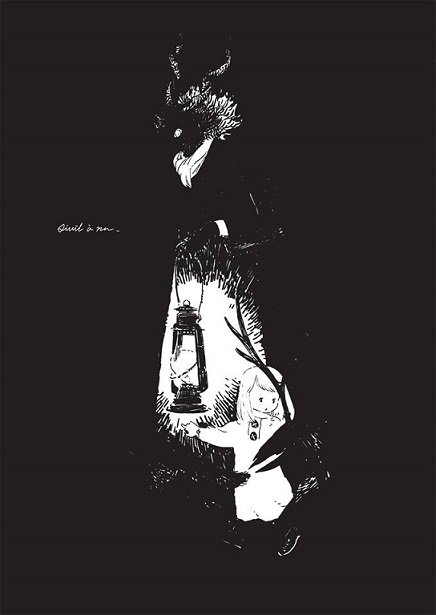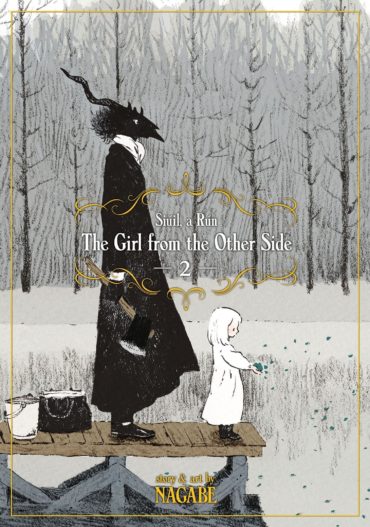The Girl from the Other Side: Siúil, a Rún Volume 2 Review
A little girl, Shiva, is waiting for her auntie to collect her. She lives with Teacher, a tall, black, horned creature, one of the Outsiders who are feared and shunned by those who live Inside. Shiva and Teacher can never touch – for if Teacher touches her, he will taint her and she will become as black and monstrous as he. Or so he believes. But when another Outsider breaks in and touches Shiva, Teacher – in despair – tries to destroy it in a desperate bid to protect her. The aftermath of this strange and disturbing invasion only serves to open up more questions than it answers about what happens when a mortal is touched by an Outsider. Do the answers lie in the lake in the forest? Teacher and Shiva set off to find out.
The first volume of The Girl from the Other Side has been my manga coup de coeur of 2017 so far – but after delivering such an atmospheric and enticing opening, has Nagabe managed the challenge of fulfilling the promise of the early chapters? The art is still deliciously sombre; darkness seems to exude from the page like a dark fog, tainting all that it encompasses. Shiva, the little girl at the heart of the story, the one Teacher strives to protect from harm, is by contrast, all light: white clothes, fair haired, sweet-natured and innocently trusting. But mangaka Nagabe has to move the story onward and, in doing so, inevitably he has to clarify some of the ambiguities and hints that made the first volume so powerful. A favourite storytelling technique favoured by mangaka (especially CLAMP) is for characters to seem to be on the point of sharing a vital nugget of information or personal revelation and then everything to trail away, unfinished, in ellipses… This ambiguity can be irresistible at first, allowing the reader to attach all kinds of significance to the unfinished statement. However, if left unresolved, it ends up frustrating the progress of the story – and, inevitably, the reader who grows impatient with such vagueness. This second volume disappoints – just a little – because Nagabe begins to steer the story away from the deliciously unknowable mysteries hinted at in the first chapters. Authors just can’t win in this situation! Reveal too little and the reader is left frustrated, reveal a little too much and the reader is disappointed because the story seems to be going in a more conventional direction than they originally anticipated.
 One of the main strengths of this story of dark and light is the distinctive nature of Nagabe’s art: much of the action is still conveyed by panels and images alone. A disturbingly powerful example of this is the confrontation in Chapter 6 between Teacher and the sinister creature of darkness (with horns like branches) that has broken into Shiva’s bedroom. Where this volume is slightly less successful than the first (and that is, as always with manga, partly due to the problems of compiling individual chapters from a magazine) is in the balance. When the focus eventually shifts back to the humans in the Inside world, setting up an encounter whose potential outcome hangs like a menacing storm cloud over the end of the volume, it feels a little unbalanced.
One of the main strengths of this story of dark and light is the distinctive nature of Nagabe’s art: much of the action is still conveyed by panels and images alone. A disturbingly powerful example of this is the confrontation in Chapter 6 between Teacher and the sinister creature of darkness (with horns like branches) that has broken into Shiva’s bedroom. Where this volume is slightly less successful than the first (and that is, as always with manga, partly due to the problems of compiling individual chapters from a magazine) is in the balance. When the focus eventually shifts back to the humans in the Inside world, setting up an encounter whose potential outcome hangs like a menacing storm cloud over the end of the volume, it feels a little unbalanced.
The edition from Seven Seas includes two colour plates (one of the cover image) and four quirky 4-koma strips: two entitled ‘A Bonus from the Other Side’ and two entitled ‘A Bonus from the Outside’. The preview at the end promises more of ‘A tranquil fairy tale about those human and inhuman’ in Volume 3. The choice of the word ‘tranquil’ still intrigues me; certainly the domestic scenes with Shiva and Teacher cooking or sewing are both charming and touching but the scenes dealing with the church and the forest are fraught with menace. Adrienne Beck again provides an excellent translation.
In Summary
An engaging follow-up to the exquisitely drawn first volume which – even though not quite so successful – still manages to enchant and chill in equal measure.
© nagabe / MAG Garden


